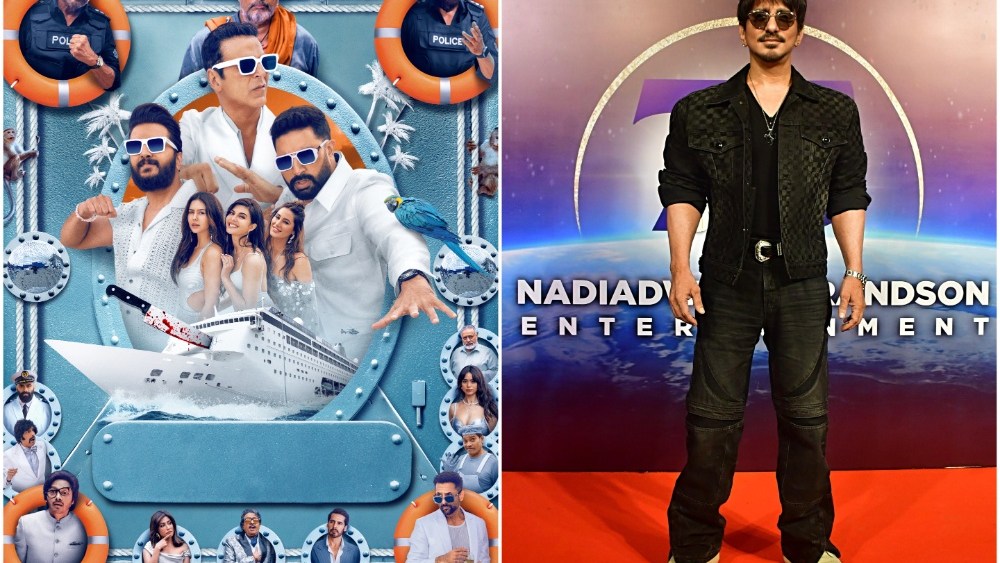While Hollywood has largely abandoned the multiple endings theatrical model since “Clue” experimented with three different conclusions in 1985, Sajid Nadiadwala is reviving the concept for Indian audiences with “Housefull 5,” betting that it will resonate in today’s experience-hungry market.
The ambitious release strategy represents more than just a gimmick for the comedy franchise’s fifth installment. It’s a calculated response to changing audience behaviors, streaming competition, and the need to create “must-see-in-theaters” experiences that can’t be replicated at home.
“The idea of having multiple endings, multiple experiences has been with me for 30 years,” reveals producer Nadiadwala, who sees the cruise ship-set murder mystery as the perfect vehicle for his long-harbored concept. “Since I wanted to make ‘Housefull 5’ a thriller comedy, there couldn’t have been a better way to execute my idea of having multiple endings than this.”
While “Clue” pioneered the multiple endings theatrical model, “Housefull 5” employs a comprehensive strategic approach. The film follows three impostors claiming to be billionaire Mr. Dobriyal’s heir “Jolly” as they compete for his fortune aboard a luxury 20-story cruise ship, with the mystery’s resolution varying by screening.
The operational complexity is staggering. Major exhibition chains are programming both versions —labeled “Housefull 5A” and “Housefull 5B” — across their circuits, either on different screens or at staggered showtimes. “Each of our locations will screen both versions of the film,” confirms Kamal Gianchandani, chief business planning and strategy at PVR Inox, India’s largest multiplex chain. “This gives moviegoers more choice, more engagement, and more reason to return to the theater.”
For distributors, the format creates both opportunities and challenges. Sanjay Chatar of Pen Marudhar describes it as adding “an entirely new layer of interactivity to the theatrical experience,” requiring close collaboration with exhibitors to ensure “optimal programming, audience flow, and discoverability across locations.”
The international dimension adds another layer of complexity. Aditya Chatar of overseas distributor Marudhar Entertainment sees the multi-ending structure as allowing “regional distributors and exhibitors to tailor release strategies based on audience sensibilities and viewing trends” across diaspora and crossover markets.
From a creative standpoint, director Tarun Mansukhani helms the project from a screenplay by Sajid Nadiadwala, with Farhad Samji and Tarun Mansukhani credited as writers and Nadiadwala providing the story, managing an ensemble cast including Akshay Kumar, Riteish Deshmukh, and Abhishek Bachchan as the competing “Jollys,” with Nargis Fakhri, Sonam Bajwa, and Jacqueline Fernandez as the leading ladies. The supporting cast features Sanjay Dutt, Jackie Shroff, Nana Patekar, and Chunky Panday.
“The idea of different endings came from a simple question: why should the audience always have just one version of the truth in a thriller?” Nadiadwala explains. “With ‘Housefull 5,’ we’ve built a film that plays with form while staying completely rooted in entertainment.”
The marketing implications are perhaps the most intriguing aspect. The curiosity factor around “which ending did you watch?” becomes what Chatar calls “a marketing tool in itself – encouraging not just ticket sales, but cultural conversation.” This organic word-of-mouth potential opens doors for “multi-phase campaigns, targeted social storytelling, and influencer-driven word-of-mouth.”
Devang Sampat of multiplex chain Cinepolis India recognizes the broader industry implications: “We see this as an important moment for theatrical exhibition, where storytelling and cinema operations meet in a way that feels fresh and commercially exciting.”
The timing aligns with production company Nadiadwala Grandson Entertainment’s 75th anniversary celebration. “It felt right to do something radical as we celebrate 75 years of Nadiadwala Grandson in the industry,” Nadiadwala notes. “‘Housefull’ is India’s biggest comedy franchise and for the fifth installment, we had to push the boundaries of what comedy can be.”
The previous four films in the franchise released in 2010, 2012, 2016 and 2019 respectively and together grossed $118 million.
Nadiadwala positions the experiment within broader industry trends: “It’s a natural extension of the theatrical experience: creating intrigue, rewatch value, and a sense of discovery. In a world of spoilers and algorithms, we’re bringing back that element of surprise.”
“Housefull 5” benefits from established franchise recognition, sophisticated exhibition networks, and social media amplification capabilities that didn’t exist when “Clue” experimented with multiple endings nearly four decades ago.
The success or failure of this strategy could determine whether other Indian filmmakers embrace similar theatrical innovations. For Nadiadwala, it represents the culmination of decades of creative ambition: “Our legacy has always been about embracing scale, stars, and giving audiences newer experiences and ‘Housefull 5’ takes all it to another level.”
Barring “Chhaava,” in recent times, the Hindi-language Bollywood industry has taken somewhat of a battering at the box office. This has been redeemed partially in the past few weeks by the encouraging performance of “Bhool Chuk Maaf,” “Raid 2,” “Kesari Chapter 2” and “Jaat.”
As “Housefull 5” prepares for its unprecedented release on June 6, the industry watches closely to see if multiple endings can provide the theatrical differentiation that exhibitors desperately need in an increasingly digital entertainment landscape. The answer may reshape how commercial Indian cinema approaches audience engagement in the streaming age.
Read the full article here


